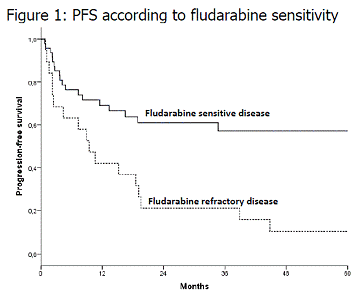Abstract
Allogeneic hematopoietic stem cell transplantation (HSCT) is a potentially curative treatment for chronic lymphocytic leukemia/small lymphocytic lymphoma (CLL/SLL) and is performed in patients (pts) with high-risk features at diagnosis (del17p/p53 mutations) or advanced disease. Although approximately 30% of pts have matched siblings, alternative stem cell sources such as umbilical cord blood, extend the use of HSCT to pts lacking a conventional donor. However, little is known about outcomes after umbilical cord blood transplantation (UCBT) for CLL/SLL.
We analyzed 68 pts (50 males) who underwent a single (n=16) or double (n=52) HLA-mismatched UCBT between 2004 and 2012 in 34 EBMT centers. Median age at UCBT was 57 years (yrs) (range, 27-68). At diagnosis, 56 pts had CLL/SLL, 8 prolymphocytic leukemia (4 B-cell and 4 T-cell) and 4 Richter transformations. Cytogenetic was available in 70% (48/68) of pts. Seventy-three percent had abnormal karyotype (36% del17p/p53, 17% del13q, 8% del11q and 12% others) and 27% normal. Median time from diagnosis to UCBT was 54 months (range, 3-358). Thirty-seven pts were in partial remission (PR) at UCBT, 23 in complete remission (CR) and 8 had refractory disease (RD). The hematopoietic stem cell comordibity index (HCT-CI) at UCBT was 0 in 60% of pts, 1-2 in 25% and 3-4 in 15%. Sixty-five percent of pts received ≥3 chemotherapy lines prior to UCBT, 28% were refractory to purine analogues and 16% underwent previous autologous stem cell transplantation (ASCT). Sixty patients received low-dose TBI (2-4 Gy) from which the Minnesota RIC regimen (TBI-Cyclophosphamide-Fludarabine: TCF) was given to 57 pts; 15 pts received ATG and GVHD prophylaxis was CsA+MMF in 61 pts. Median TNC collected was 3.7x107/Kg (1.8-7.1) for single and 5x107/Kg (2.0-9.7) for double UCBT. Units were HLA matched to the recipient at 5-6 loci in 30% of pts and at ≤4 in 70%.
Median follow-up was 37 months (range, 3-98). OS and PFS at 3 yrs were, respectively, 53±7% and 45±7%. The cumulative incidences (CI) of neutrophils and platelets engraftment were 84±5% and 72±6%, respectively with a median time for engraftment of 21(range, 5-67) and 43 (range, 1-189) days, respectively. CI of acute graft-versus-host disease (aGVHD) at 100 days was 43%±6 for grade II-IV and 19±5% for grade III-IV with a median time of onset of 23 days (9-95). Three yrs CI of chronic GVHD (cGVHD) was 32±6% (12 limited and 6 extensive) with a median time of onset of 130 (range, 101-393) days. CI of relapse and NRM at 3 yrs were,16±5% and 39±6%, respectively.
In a univariate analysis the use of TCF conditioning was associated with improved OS (62% vs 15%, p<0.001), PFS (52% vs 15%, p<0.001) and lower NRM (34% vs 66%, p=0.008). CMV negative serology prior UCBT was associated with higher OS (71% vs 41%, p=0.02). Fludarabine sensitive disease at transplantation was associated to improved OS (70 vs 21%, p<0,001), PFS (57% vs 21%, p=0.001 – figure 1) and lower NRM (30% vs 58%, p=0.009). Patients who received ATG had lower incidence of aGVHD grades II-IV (14% vs 45%, p=0.02). The HCT-CI ≤2 was associated with improved PFS (51 vs 25%, p=0.04). Patients who received ASCT prior to UCBT had higher rates of engraftment (91% vs 82%, p=0.03). No risk factors were associated with cGVHD or relapse. Twelve patients relapsed or progressed after UCBT, of which 8 were transplanted in PR or had RD at time of transplant. Median time to relapse or progression was 19 months (2-89).
The use of TCF (HR: 0.34 (0.14-0.82), p=0.02), fludarabine sensitive disease at transplantation (HR: 0.41 (0.20-0.81), p=0.01) and HCT-CI ≤2 (HR: 0.38 (0.17-0.87), p=0.02) were associated with improved PFS in multivariate analysis. Acute GVHD grade III-IV was associated with lower OS (HR: 3.4 (1.6-7.4), p=0.002) and PFS (HR: 2.8 (1.4-5.8), p=0.005) in a time-dependent model. Overall, 32 patients died; 7 died of relapse and 25 of transplant related causes (10 infections, 4 post-transplant lymphoprolypherative diseases, 3 aGVHD, 3 toxicities, 1 secondary lung cancer and 4 other causes).
In conclusion, RIC-UCBT appears to be a valid option for CLL/SLL patients. Strategies to optimize infection prophylaxis, use of low-dose TBI RIC conditionings and to perform the UCBT before development of fludarabine resistance may improve overall outcome.
No relevant conflicts of interest to declare.
Author notes
Asterisk with author names denotes non-ASH members.


